Business Administration Report: Problem Solving at Marks & Spencer
VerifiedAdded on 2021/01/01
|14
|4416
|119
Report
AI Summary
This report provides an in-depth analysis of problem-solving techniques within the context of Marks & Spencer (M&S), a British multinational company. It explores various aspects of business administration, including the use of different problem-solving techniques, organizational and legal constraints, and the role of stakeholders in addressing business challenges. The report delves into the steps involved in the business decision-making process and the implications of adopting recommendations to solve business problems. Furthermore, it examines the purpose and benefits of continuous improvement, along with different techniques and models, such as TQM and Just-in-time. The report also evaluates the scope and scale of a problem, the importance of feedback from stakeholders, and the nature, causes, and implications of identified problems. It assesses the possible courses of action, uses evidence to justify the approach to problem-solving, and develops a plan with success criteria. The report concludes by evaluating the degree of success and the implications of the solved problems, as well as the nature, scope, and scale of contributions to continuous improvement activities, performance measures, and standard operating procedures. The report focuses on the quality of the products of M&S and suggests improvements in the process.
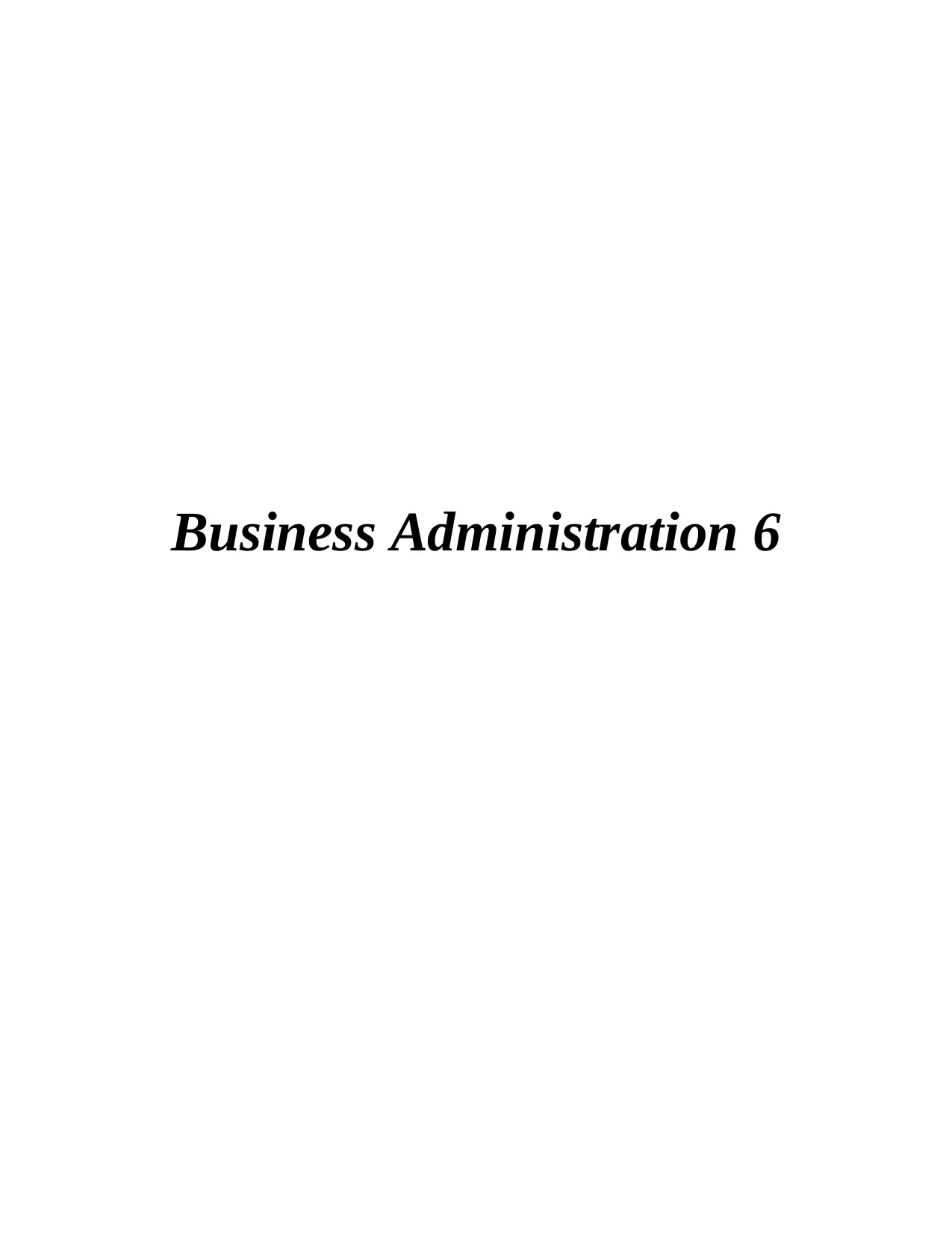
Business Administration 6
Paraphrase This Document
Need a fresh take? Get an instant paraphrase of this document with our AI Paraphraser
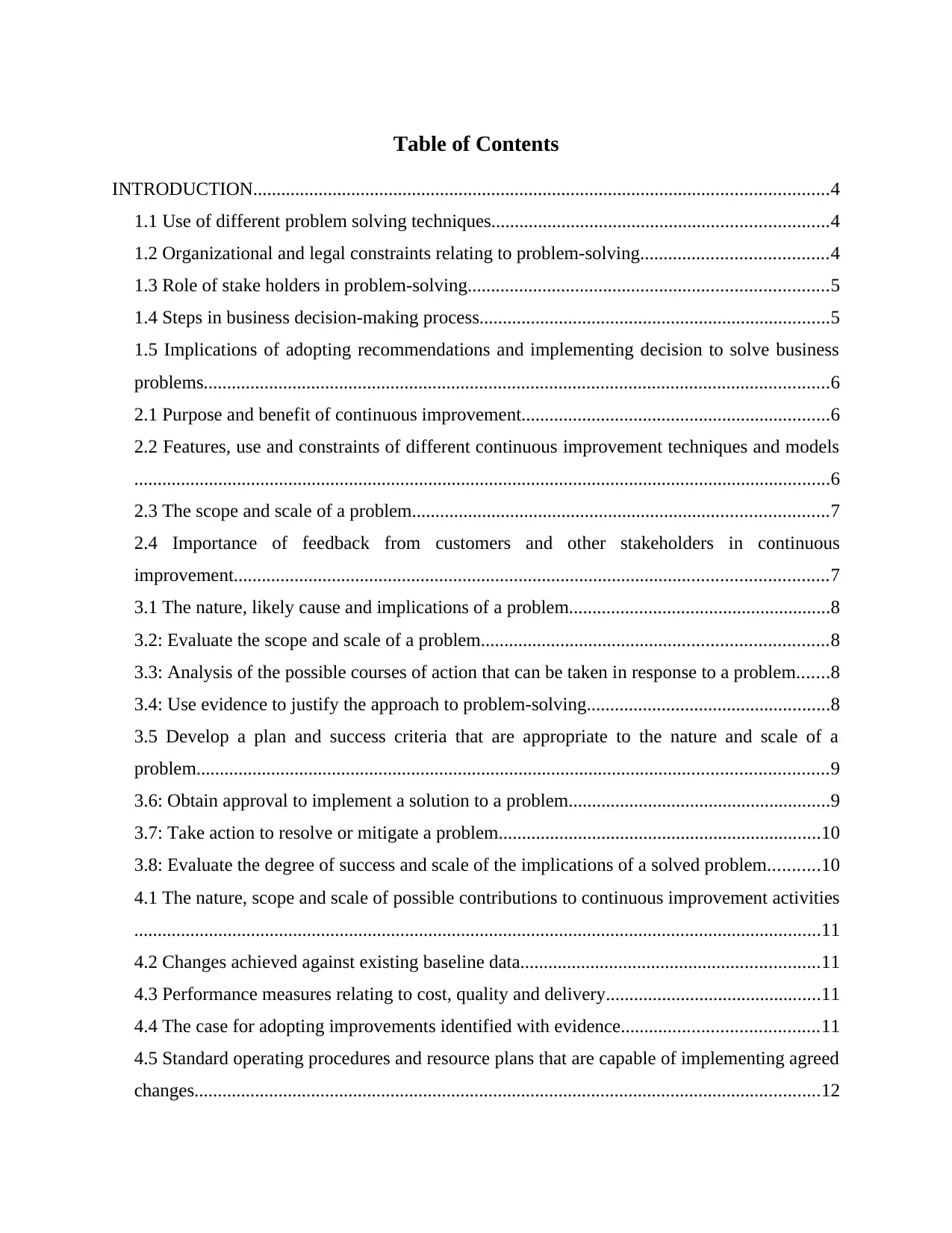
Table of Contents
INTRODUCTION...........................................................................................................................4
1.1 Use of different problem solving techniques........................................................................4
1.2 Organizational and legal constraints relating to problem-solving........................................4
1.3 Role of stake holders in problem-solving.............................................................................5
1.4 Steps in business decision-making process...........................................................................5
1.5 Implications of adopting recommendations and implementing decision to solve business
problems......................................................................................................................................6
2.1 Purpose and benefit of continuous improvement..................................................................6
2.2 Features, use and constraints of different continuous improvement techniques and models
.....................................................................................................................................................6
2.3 The scope and scale of a problem.........................................................................................7
2.4 Importance of feedback from customers and other stakeholders in continuous
improvement...............................................................................................................................7
3.1 The nature, likely cause and implications of a problem........................................................8
3.2: Evaluate the scope and scale of a problem..........................................................................8
3.3: Analysis of the possible courses of action that can be taken in response to a problem.......8
3.4: Use evidence to justify the approach to problem-solving....................................................8
3.5 Develop a plan and success criteria that are appropriate to the nature and scale of a
problem.......................................................................................................................................9
3.6: Obtain approval to implement a solution to a problem........................................................9
3.7: Take action to resolve or mitigate a problem.....................................................................10
3.8: Evaluate the degree of success and scale of the implications of a solved problem...........10
4.1 The nature, scope and scale of possible contributions to continuous improvement activities
...................................................................................................................................................11
4.2 Changes achieved against existing baseline data................................................................11
4.3 Performance measures relating to cost, quality and delivery..............................................11
4.4 The case for adopting improvements identified with evidence..........................................11
4.5 Standard operating procedures and resource plans that are capable of implementing agreed
changes......................................................................................................................................12
INTRODUCTION...........................................................................................................................4
1.1 Use of different problem solving techniques........................................................................4
1.2 Organizational and legal constraints relating to problem-solving........................................4
1.3 Role of stake holders in problem-solving.............................................................................5
1.4 Steps in business decision-making process...........................................................................5
1.5 Implications of adopting recommendations and implementing decision to solve business
problems......................................................................................................................................6
2.1 Purpose and benefit of continuous improvement..................................................................6
2.2 Features, use and constraints of different continuous improvement techniques and models
.....................................................................................................................................................6
2.3 The scope and scale of a problem.........................................................................................7
2.4 Importance of feedback from customers and other stakeholders in continuous
improvement...............................................................................................................................7
3.1 The nature, likely cause and implications of a problem........................................................8
3.2: Evaluate the scope and scale of a problem..........................................................................8
3.3: Analysis of the possible courses of action that can be taken in response to a problem.......8
3.4: Use evidence to justify the approach to problem-solving....................................................8
3.5 Develop a plan and success criteria that are appropriate to the nature and scale of a
problem.......................................................................................................................................9
3.6: Obtain approval to implement a solution to a problem........................................................9
3.7: Take action to resolve or mitigate a problem.....................................................................10
3.8: Evaluate the degree of success and scale of the implications of a solved problem...........10
4.1 The nature, scope and scale of possible contributions to continuous improvement activities
...................................................................................................................................................11
4.2 Changes achieved against existing baseline data................................................................11
4.3 Performance measures relating to cost, quality and delivery..............................................11
4.4 The case for adopting improvements identified with evidence..........................................11
4.5 Standard operating procedures and resource plans that are capable of implementing agreed
changes......................................................................................................................................12
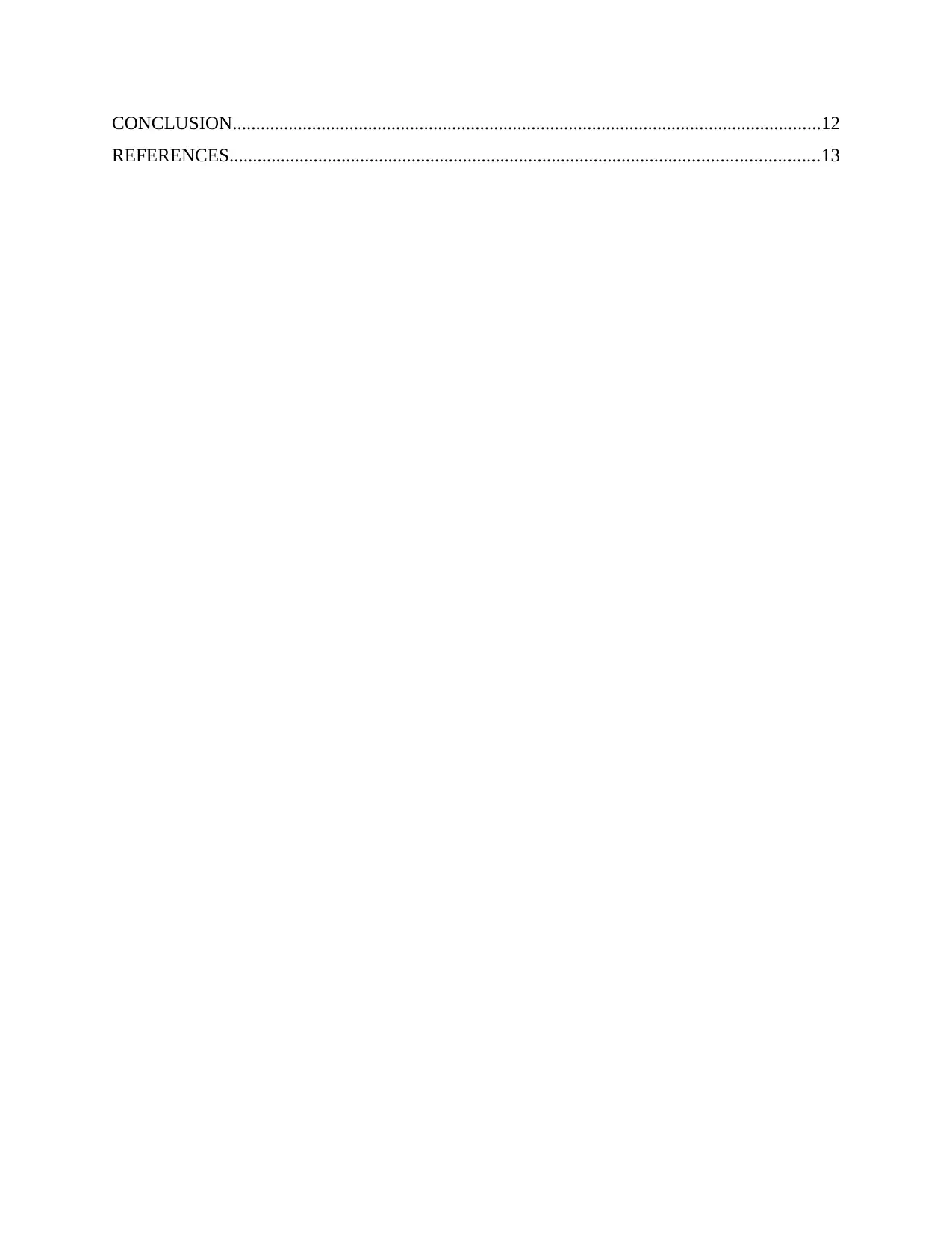
CONCLUSION..............................................................................................................................12
REFERENCES..............................................................................................................................13
REFERENCES..............................................................................................................................13
⊘ This is a preview!⊘
Do you want full access?
Subscribe today to unlock all pages.

Trusted by 1+ million students worldwide
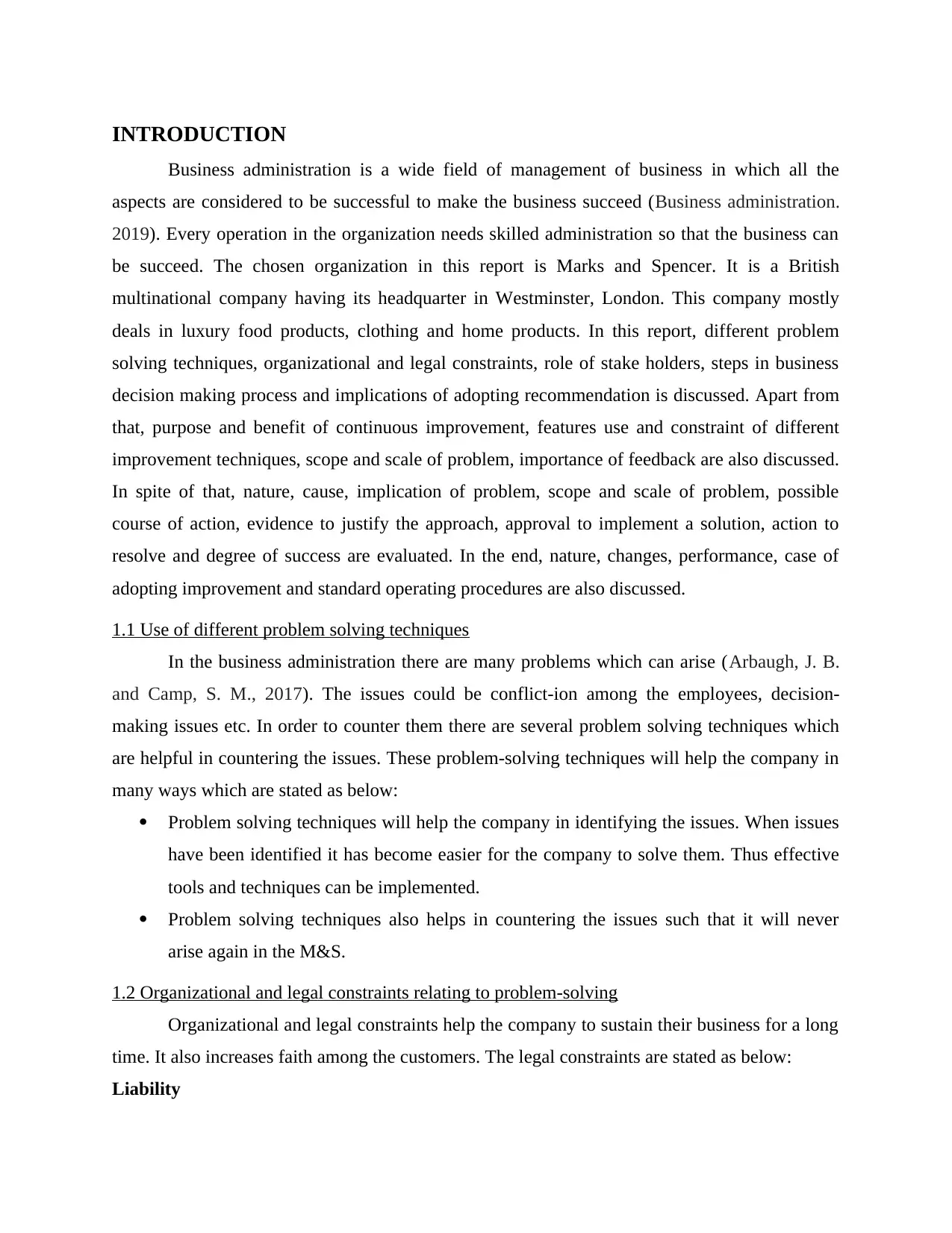
INTRODUCTION
Business administration is a wide field of management of business in which all the
aspects are considered to be successful to make the business succeed (Business administration.
2019). Every operation in the organization needs skilled administration so that the business can
be succeed. The chosen organization in this report is Marks and Spencer. It is a British
multinational company having its headquarter in Westminster, London. This company mostly
deals in luxury food products, clothing and home products. In this report, different problem
solving techniques, organizational and legal constraints, role of stake holders, steps in business
decision making process and implications of adopting recommendation is discussed. Apart from
that, purpose and benefit of continuous improvement, features use and constraint of different
improvement techniques, scope and scale of problem, importance of feedback are also discussed.
In spite of that, nature, cause, implication of problem, scope and scale of problem, possible
course of action, evidence to justify the approach, approval to implement a solution, action to
resolve and degree of success are evaluated. In the end, nature, changes, performance, case of
adopting improvement and standard operating procedures are also discussed.
1.1 Use of different problem solving techniques
In the business administration there are many problems which can arise (Arbaugh, J. B.
and Camp, S. M., 2017). The issues could be conflict-ion among the employees, decision-
making issues etc. In order to counter them there are several problem solving techniques which
are helpful in countering the issues. These problem-solving techniques will help the company in
many ways which are stated as below:
Problem solving techniques will help the company in identifying the issues. When issues
have been identified it has become easier for the company to solve them. Thus effective
tools and techniques can be implemented.
Problem solving techniques also helps in countering the issues such that it will never
arise again in the M&S.
1.2 Organizational and legal constraints relating to problem-solving
Organizational and legal constraints help the company to sustain their business for a long
time. It also increases faith among the customers. The legal constraints are stated as below:
Liability
Business administration is a wide field of management of business in which all the
aspects are considered to be successful to make the business succeed (Business administration.
2019). Every operation in the organization needs skilled administration so that the business can
be succeed. The chosen organization in this report is Marks and Spencer. It is a British
multinational company having its headquarter in Westminster, London. This company mostly
deals in luxury food products, clothing and home products. In this report, different problem
solving techniques, organizational and legal constraints, role of stake holders, steps in business
decision making process and implications of adopting recommendation is discussed. Apart from
that, purpose and benefit of continuous improvement, features use and constraint of different
improvement techniques, scope and scale of problem, importance of feedback are also discussed.
In spite of that, nature, cause, implication of problem, scope and scale of problem, possible
course of action, evidence to justify the approach, approval to implement a solution, action to
resolve and degree of success are evaluated. In the end, nature, changes, performance, case of
adopting improvement and standard operating procedures are also discussed.
1.1 Use of different problem solving techniques
In the business administration there are many problems which can arise (Arbaugh, J. B.
and Camp, S. M., 2017). The issues could be conflict-ion among the employees, decision-
making issues etc. In order to counter them there are several problem solving techniques which
are helpful in countering the issues. These problem-solving techniques will help the company in
many ways which are stated as below:
Problem solving techniques will help the company in identifying the issues. When issues
have been identified it has become easier for the company to solve them. Thus effective
tools and techniques can be implemented.
Problem solving techniques also helps in countering the issues such that it will never
arise again in the M&S.
1.2 Organizational and legal constraints relating to problem-solving
Organizational and legal constraints help the company to sustain their business for a long
time. It also increases faith among the customers. The legal constraints are stated as below:
Liability
Paraphrase This Document
Need a fresh take? Get an instant paraphrase of this document with our AI Paraphraser
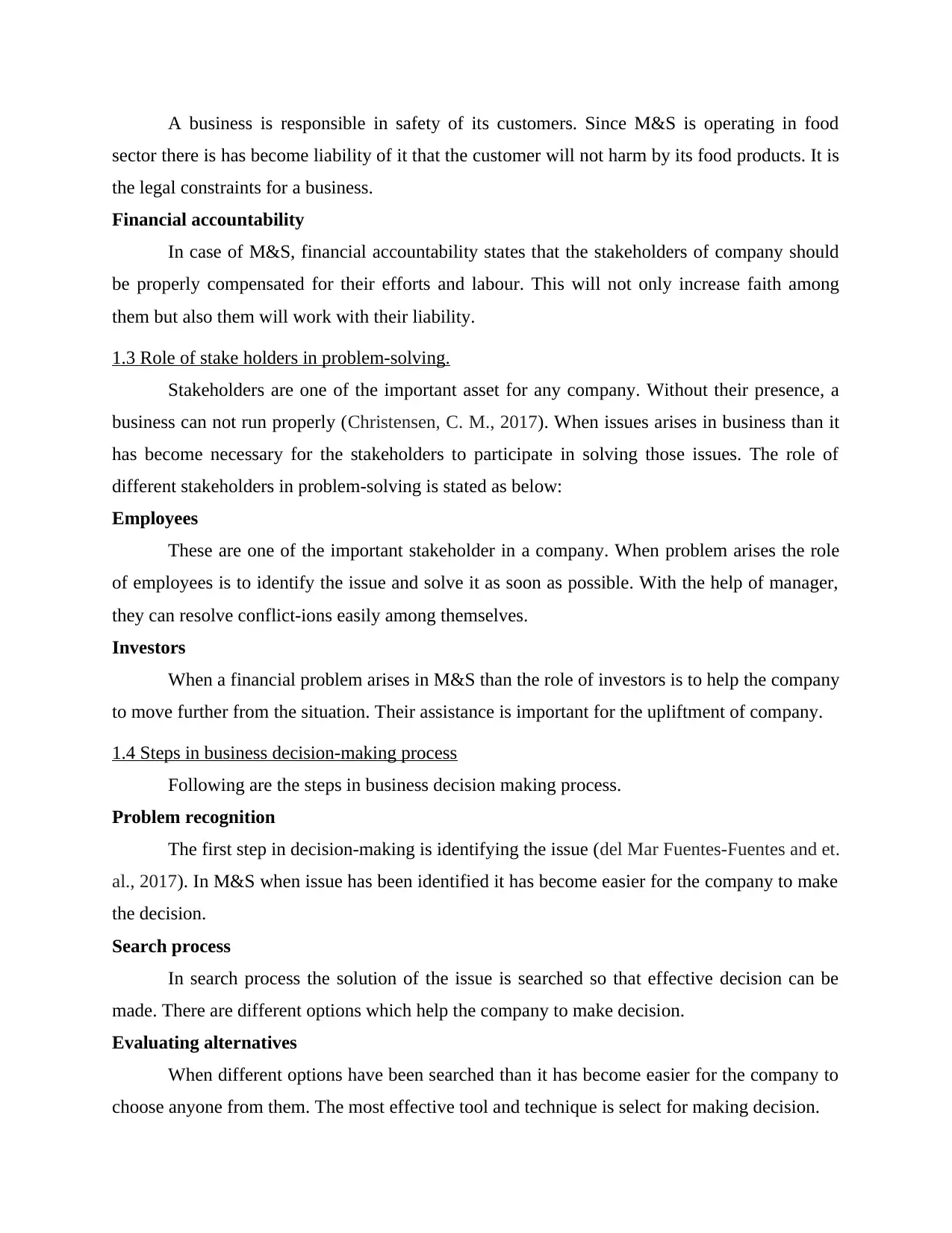
A business is responsible in safety of its customers. Since M&S is operating in food
sector there is has become liability of it that the customer will not harm by its food products. It is
the legal constraints for a business.
Financial accountability
In case of M&S, financial accountability states that the stakeholders of company should
be properly compensated for their efforts and labour. This will not only increase faith among
them but also them will work with their liability.
1.3 Role of stake holders in problem-solving.
Stakeholders are one of the important asset for any company. Without their presence, a
business can not run properly (Christensen, C. M., 2017). When issues arises in business than it
has become necessary for the stakeholders to participate in solving those issues. The role of
different stakeholders in problem-solving is stated as below:
Employees
These are one of the important stakeholder in a company. When problem arises the role
of employees is to identify the issue and solve it as soon as possible. With the help of manager,
they can resolve conflict-ions easily among themselves.
Investors
When a financial problem arises in M&S than the role of investors is to help the company
to move further from the situation. Their assistance is important for the upliftment of company.
1.4 Steps in business decision-making process
Following are the steps in business decision making process.
Problem recognition
The first step in decision-making is identifying the issue (del Mar Fuentes‐Fuentes and et.
al., 2017). In M&S when issue has been identified it has become easier for the company to make
the decision.
Search process
In search process the solution of the issue is searched so that effective decision can be
made. There are different options which help the company to make decision.
Evaluating alternatives
When different options have been searched than it has become easier for the company to
choose anyone from them. The most effective tool and technique is select for making decision.
sector there is has become liability of it that the customer will not harm by its food products. It is
the legal constraints for a business.
Financial accountability
In case of M&S, financial accountability states that the stakeholders of company should
be properly compensated for their efforts and labour. This will not only increase faith among
them but also them will work with their liability.
1.3 Role of stake holders in problem-solving.
Stakeholders are one of the important asset for any company. Without their presence, a
business can not run properly (Christensen, C. M., 2017). When issues arises in business than it
has become necessary for the stakeholders to participate in solving those issues. The role of
different stakeholders in problem-solving is stated as below:
Employees
These are one of the important stakeholder in a company. When problem arises the role
of employees is to identify the issue and solve it as soon as possible. With the help of manager,
they can resolve conflict-ions easily among themselves.
Investors
When a financial problem arises in M&S than the role of investors is to help the company
to move further from the situation. Their assistance is important for the upliftment of company.
1.4 Steps in business decision-making process
Following are the steps in business decision making process.
Problem recognition
The first step in decision-making is identifying the issue (del Mar Fuentes‐Fuentes and et.
al., 2017). In M&S when issue has been identified it has become easier for the company to make
the decision.
Search process
In search process the solution of the issue is searched so that effective decision can be
made. There are different options which help the company to make decision.
Evaluating alternatives
When different options have been searched than it has become easier for the company to
choose anyone from them. The most effective tool and technique is select for making decision.
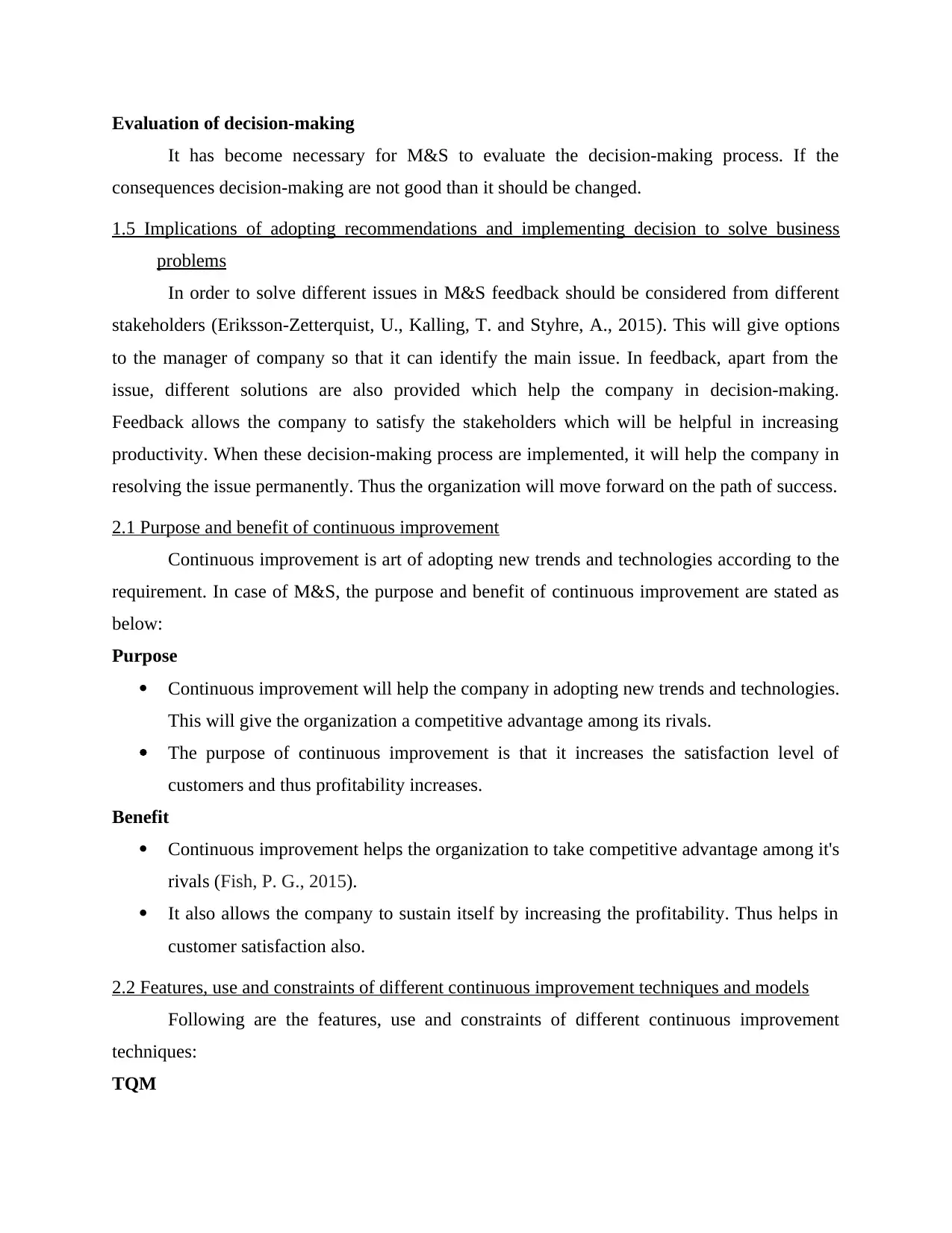
Evaluation of decision-making
It has become necessary for M&S to evaluate the decision-making process. If the
consequences decision-making are not good than it should be changed.
1.5 Implications of adopting recommendations and implementing decision to solve business
problems
In order to solve different issues in M&S feedback should be considered from different
stakeholders (Eriksson-Zetterquist, U., Kalling, T. and Styhre, A., 2015). This will give options
to the manager of company so that it can identify the main issue. In feedback, apart from the
issue, different solutions are also provided which help the company in decision-making.
Feedback allows the company to satisfy the stakeholders which will be helpful in increasing
productivity. When these decision-making process are implemented, it will help the company in
resolving the issue permanently. Thus the organization will move forward on the path of success.
2.1 Purpose and benefit of continuous improvement
Continuous improvement is art of adopting new trends and technologies according to the
requirement. In case of M&S, the purpose and benefit of continuous improvement are stated as
below:
Purpose
Continuous improvement will help the company in adopting new trends and technologies.
This will give the organization a competitive advantage among its rivals.
The purpose of continuous improvement is that it increases the satisfaction level of
customers and thus profitability increases.
Benefit
Continuous improvement helps the organization to take competitive advantage among it's
rivals (Fish, P. G., 2015).
It also allows the company to sustain itself by increasing the profitability. Thus helps in
customer satisfaction also.
2.2 Features, use and constraints of different continuous improvement techniques and models
Following are the features, use and constraints of different continuous improvement
techniques:
TQM
It has become necessary for M&S to evaluate the decision-making process. If the
consequences decision-making are not good than it should be changed.
1.5 Implications of adopting recommendations and implementing decision to solve business
problems
In order to solve different issues in M&S feedback should be considered from different
stakeholders (Eriksson-Zetterquist, U., Kalling, T. and Styhre, A., 2015). This will give options
to the manager of company so that it can identify the main issue. In feedback, apart from the
issue, different solutions are also provided which help the company in decision-making.
Feedback allows the company to satisfy the stakeholders which will be helpful in increasing
productivity. When these decision-making process are implemented, it will help the company in
resolving the issue permanently. Thus the organization will move forward on the path of success.
2.1 Purpose and benefit of continuous improvement
Continuous improvement is art of adopting new trends and technologies according to the
requirement. In case of M&S, the purpose and benefit of continuous improvement are stated as
below:
Purpose
Continuous improvement will help the company in adopting new trends and technologies.
This will give the organization a competitive advantage among its rivals.
The purpose of continuous improvement is that it increases the satisfaction level of
customers and thus profitability increases.
Benefit
Continuous improvement helps the organization to take competitive advantage among it's
rivals (Fish, P. G., 2015).
It also allows the company to sustain itself by increasing the profitability. Thus helps in
customer satisfaction also.
2.2 Features, use and constraints of different continuous improvement techniques and models
Following are the features, use and constraints of different continuous improvement
techniques:
TQM
⊘ This is a preview!⊘
Do you want full access?
Subscribe today to unlock all pages.

Trusted by 1+ million students worldwide
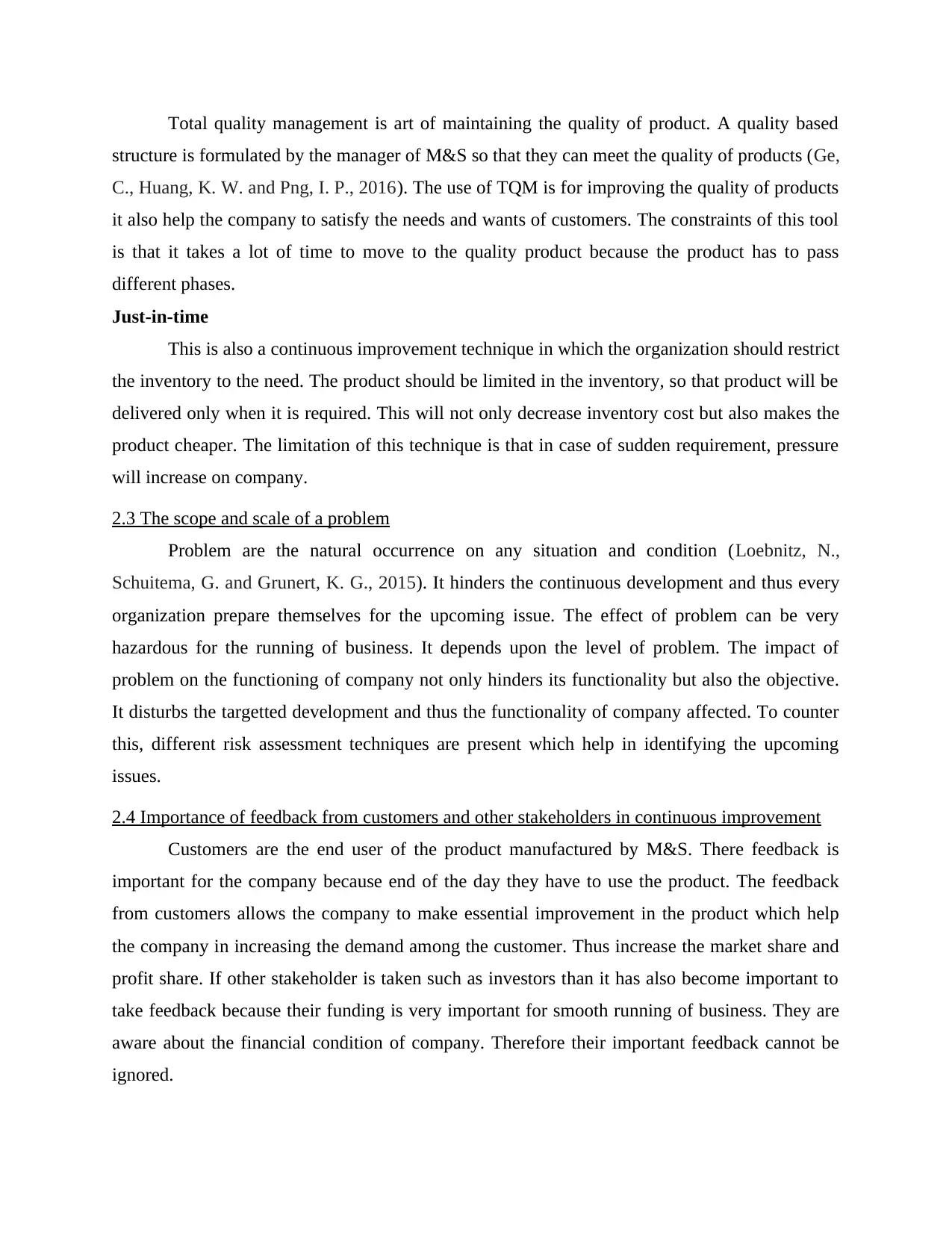
Total quality management is art of maintaining the quality of product. A quality based
structure is formulated by the manager of M&S so that they can meet the quality of products (Ge,
C., Huang, K. W. and Png, I. P., 2016). The use of TQM is for improving the quality of products
it also help the company to satisfy the needs and wants of customers. The constraints of this tool
is that it takes a lot of time to move to the quality product because the product has to pass
different phases.
Just-in-time
This is also a continuous improvement technique in which the organization should restrict
the inventory to the need. The product should be limited in the inventory, so that product will be
delivered only when it is required. This will not only decrease inventory cost but also makes the
product cheaper. The limitation of this technique is that in case of sudden requirement, pressure
will increase on company.
2.3 The scope and scale of a problem
Problem are the natural occurrence on any situation and condition (Loebnitz, N.,
Schuitema, G. and Grunert, K. G., 2015). It hinders the continuous development and thus every
organization prepare themselves for the upcoming issue. The effect of problem can be very
hazardous for the running of business. It depends upon the level of problem. The impact of
problem on the functioning of company not only hinders its functionality but also the objective.
It disturbs the targetted development and thus the functionality of company affected. To counter
this, different risk assessment techniques are present which help in identifying the upcoming
issues.
2.4 Importance of feedback from customers and other stakeholders in continuous improvement
Customers are the end user of the product manufactured by M&S. There feedback is
important for the company because end of the day they have to use the product. The feedback
from customers allows the company to make essential improvement in the product which help
the company in increasing the demand among the customer. Thus increase the market share and
profit share. If other stakeholder is taken such as investors than it has also become important to
take feedback because their funding is very important for smooth running of business. They are
aware about the financial condition of company. Therefore their important feedback cannot be
ignored.
structure is formulated by the manager of M&S so that they can meet the quality of products (Ge,
C., Huang, K. W. and Png, I. P., 2016). The use of TQM is for improving the quality of products
it also help the company to satisfy the needs and wants of customers. The constraints of this tool
is that it takes a lot of time to move to the quality product because the product has to pass
different phases.
Just-in-time
This is also a continuous improvement technique in which the organization should restrict
the inventory to the need. The product should be limited in the inventory, so that product will be
delivered only when it is required. This will not only decrease inventory cost but also makes the
product cheaper. The limitation of this technique is that in case of sudden requirement, pressure
will increase on company.
2.3 The scope and scale of a problem
Problem are the natural occurrence on any situation and condition (Loebnitz, N.,
Schuitema, G. and Grunert, K. G., 2015). It hinders the continuous development and thus every
organization prepare themselves for the upcoming issue. The effect of problem can be very
hazardous for the running of business. It depends upon the level of problem. The impact of
problem on the functioning of company not only hinders its functionality but also the objective.
It disturbs the targetted development and thus the functionality of company affected. To counter
this, different risk assessment techniques are present which help in identifying the upcoming
issues.
2.4 Importance of feedback from customers and other stakeholders in continuous improvement
Customers are the end user of the product manufactured by M&S. There feedback is
important for the company because end of the day they have to use the product. The feedback
from customers allows the company to make essential improvement in the product which help
the company in increasing the demand among the customer. Thus increase the market share and
profit share. If other stakeholder is taken such as investors than it has also become important to
take feedback because their funding is very important for smooth running of business. They are
aware about the financial condition of company. Therefore their important feedback cannot be
ignored.
Paraphrase This Document
Need a fresh take? Get an instant paraphrase of this document with our AI Paraphraser
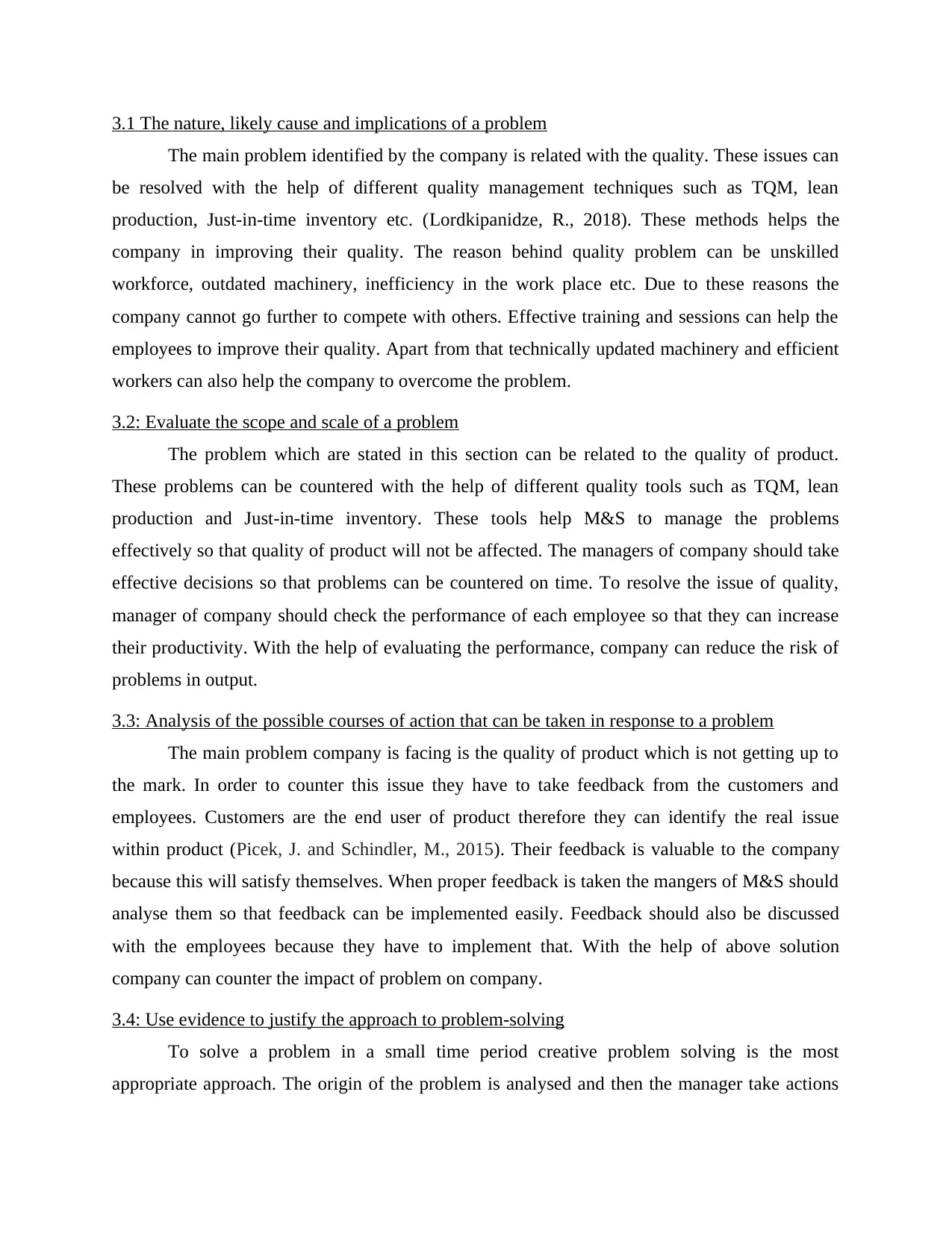
3.1 The nature, likely cause and implications of a problem
The main problem identified by the company is related with the quality. These issues can
be resolved with the help of different quality management techniques such as TQM, lean
production, Just-in-time inventory etc. (Lordkipanidze, R., 2018). These methods helps the
company in improving their quality. The reason behind quality problem can be unskilled
workforce, outdated machinery, inefficiency in the work place etc. Due to these reasons the
company cannot go further to compete with others. Effective training and sessions can help the
employees to improve their quality. Apart from that technically updated machinery and efficient
workers can also help the company to overcome the problem.
3.2: Evaluate the scope and scale of a problem
The problem which are stated in this section can be related to the quality of product.
These problems can be countered with the help of different quality tools such as TQM, lean
production and Just-in-time inventory. These tools help M&S to manage the problems
effectively so that quality of product will not be affected. The managers of company should take
effective decisions so that problems can be countered on time. To resolve the issue of quality,
manager of company should check the performance of each employee so that they can increase
their productivity. With the help of evaluating the performance, company can reduce the risk of
problems in output.
3.3: Analysis of the possible courses of action that can be taken in response to a problem
The main problem company is facing is the quality of product which is not getting up to
the mark. In order to counter this issue they have to take feedback from the customers and
employees. Customers are the end user of product therefore they can identify the real issue
within product (Picek, J. and Schindler, M., 2015). Their feedback is valuable to the company
because this will satisfy themselves. When proper feedback is taken the mangers of M&S should
analyse them so that feedback can be implemented easily. Feedback should also be discussed
with the employees because they have to implement that. With the help of above solution
company can counter the impact of problem on company.
3.4: Use evidence to justify the approach to problem-solving
To solve a problem in a small time period creative problem solving is the most
appropriate approach. The origin of the problem is analysed and then the manager take actions
The main problem identified by the company is related with the quality. These issues can
be resolved with the help of different quality management techniques such as TQM, lean
production, Just-in-time inventory etc. (Lordkipanidze, R., 2018). These methods helps the
company in improving their quality. The reason behind quality problem can be unskilled
workforce, outdated machinery, inefficiency in the work place etc. Due to these reasons the
company cannot go further to compete with others. Effective training and sessions can help the
employees to improve their quality. Apart from that technically updated machinery and efficient
workers can also help the company to overcome the problem.
3.2: Evaluate the scope and scale of a problem
The problem which are stated in this section can be related to the quality of product.
These problems can be countered with the help of different quality tools such as TQM, lean
production and Just-in-time inventory. These tools help M&S to manage the problems
effectively so that quality of product will not be affected. The managers of company should take
effective decisions so that problems can be countered on time. To resolve the issue of quality,
manager of company should check the performance of each employee so that they can increase
their productivity. With the help of evaluating the performance, company can reduce the risk of
problems in output.
3.3: Analysis of the possible courses of action that can be taken in response to a problem
The main problem company is facing is the quality of product which is not getting up to
the mark. In order to counter this issue they have to take feedback from the customers and
employees. Customers are the end user of product therefore they can identify the real issue
within product (Picek, J. and Schindler, M., 2015). Their feedback is valuable to the company
because this will satisfy themselves. When proper feedback is taken the mangers of M&S should
analyse them so that feedback can be implemented easily. Feedback should also be discussed
with the employees because they have to implement that. With the help of above solution
company can counter the impact of problem on company.
3.4: Use evidence to justify the approach to problem-solving
To solve a problem in a small time period creative problem solving is the most
appropriate approach. The origin of the problem is analysed and then the manager take actions
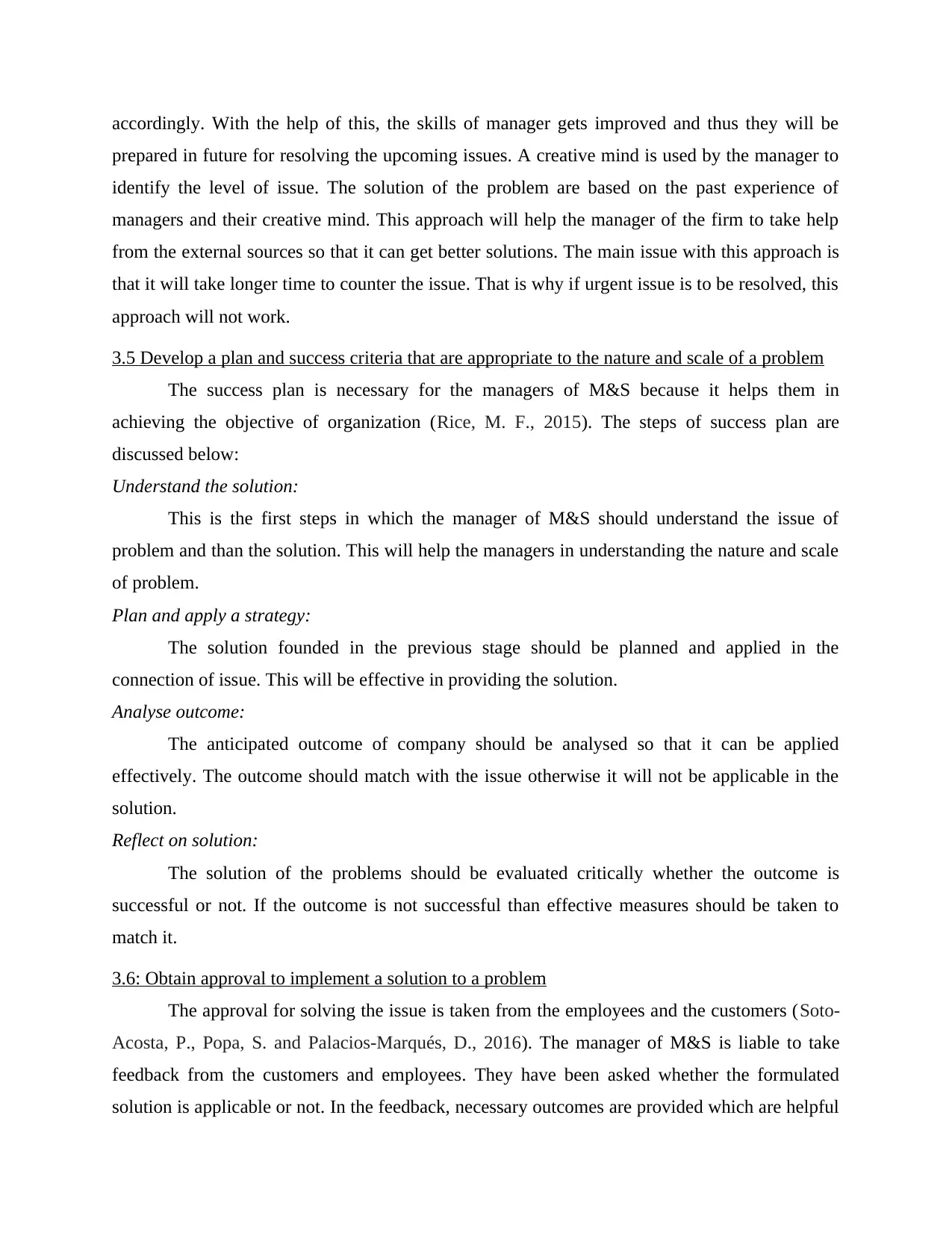
accordingly. With the help of this, the skills of manager gets improved and thus they will be
prepared in future for resolving the upcoming issues. A creative mind is used by the manager to
identify the level of issue. The solution of the problem are based on the past experience of
managers and their creative mind. This approach will help the manager of the firm to take help
from the external sources so that it can get better solutions. The main issue with this approach is
that it will take longer time to counter the issue. That is why if urgent issue is to be resolved, this
approach will not work.
3.5 Develop a plan and success criteria that are appropriate to the nature and scale of a problem
The success plan is necessary for the managers of M&S because it helps them in
achieving the objective of organization (Rice, M. F., 2015). The steps of success plan are
discussed below:
Understand the solution:
This is the first steps in which the manager of M&S should understand the issue of
problem and than the solution. This will help the managers in understanding the nature and scale
of problem.
Plan and apply a strategy:
The solution founded in the previous stage should be planned and applied in the
connection of issue. This will be effective in providing the solution.
Analyse outcome:
The anticipated outcome of company should be analysed so that it can be applied
effectively. The outcome should match with the issue otherwise it will not be applicable in the
solution.
Reflect on solution:
The solution of the problems should be evaluated critically whether the outcome is
successful or not. If the outcome is not successful than effective measures should be taken to
match it.
3.6: Obtain approval to implement a solution to a problem
The approval for solving the issue is taken from the employees and the customers (Soto-
Acosta, P., Popa, S. and Palacios-Marqués, D., 2016). The manager of M&S is liable to take
feedback from the customers and employees. They have been asked whether the formulated
solution is applicable or not. In the feedback, necessary outcomes are provided which are helpful
prepared in future for resolving the upcoming issues. A creative mind is used by the manager to
identify the level of issue. The solution of the problem are based on the past experience of
managers and their creative mind. This approach will help the manager of the firm to take help
from the external sources so that it can get better solutions. The main issue with this approach is
that it will take longer time to counter the issue. That is why if urgent issue is to be resolved, this
approach will not work.
3.5 Develop a plan and success criteria that are appropriate to the nature and scale of a problem
The success plan is necessary for the managers of M&S because it helps them in
achieving the objective of organization (Rice, M. F., 2015). The steps of success plan are
discussed below:
Understand the solution:
This is the first steps in which the manager of M&S should understand the issue of
problem and than the solution. This will help the managers in understanding the nature and scale
of problem.
Plan and apply a strategy:
The solution founded in the previous stage should be planned and applied in the
connection of issue. This will be effective in providing the solution.
Analyse outcome:
The anticipated outcome of company should be analysed so that it can be applied
effectively. The outcome should match with the issue otherwise it will not be applicable in the
solution.
Reflect on solution:
The solution of the problems should be evaluated critically whether the outcome is
successful or not. If the outcome is not successful than effective measures should be taken to
match it.
3.6: Obtain approval to implement a solution to a problem
The approval for solving the issue is taken from the employees and the customers (Soto-
Acosta, P., Popa, S. and Palacios-Marqués, D., 2016). The manager of M&S is liable to take
feedback from the customers and employees. They have been asked whether the formulated
solution is applicable or not. In the feedback, necessary outcomes are provided which are helpful
⊘ This is a preview!⊘
Do you want full access?
Subscribe today to unlock all pages.

Trusted by 1+ million students worldwide
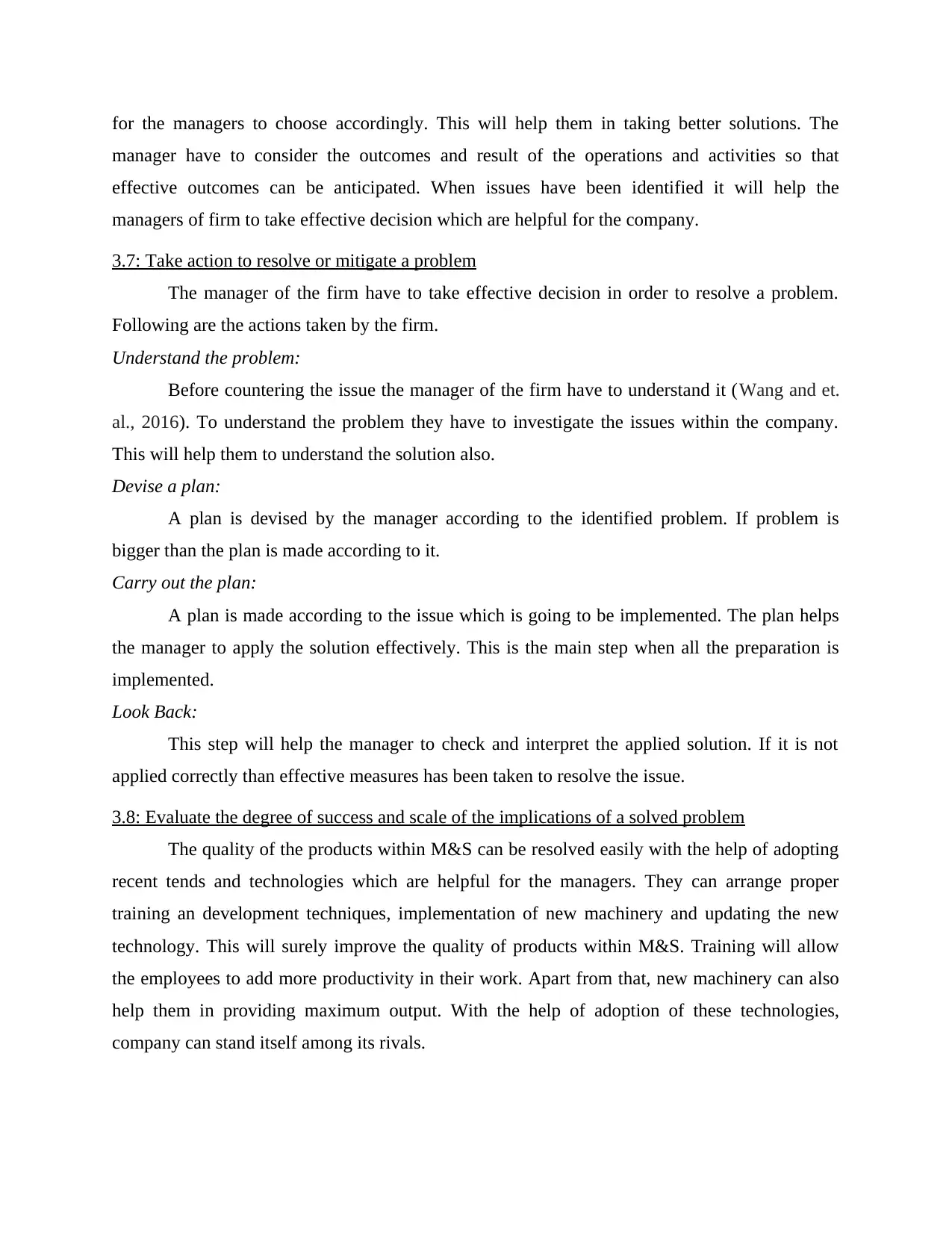
for the managers to choose accordingly. This will help them in taking better solutions. The
manager have to consider the outcomes and result of the operations and activities so that
effective outcomes can be anticipated. When issues have been identified it will help the
managers of firm to take effective decision which are helpful for the company.
3.7: Take action to resolve or mitigate a problem
The manager of the firm have to take effective decision in order to resolve a problem.
Following are the actions taken by the firm.
Understand the problem:
Before countering the issue the manager of the firm have to understand it (Wang and et.
al., 2016). To understand the problem they have to investigate the issues within the company.
This will help them to understand the solution also.
Devise a plan:
A plan is devised by the manager according to the identified problem. If problem is
bigger than the plan is made according to it.
Carry out the plan:
A plan is made according to the issue which is going to be implemented. The plan helps
the manager to apply the solution effectively. This is the main step when all the preparation is
implemented.
Look Back:
This step will help the manager to check and interpret the applied solution. If it is not
applied correctly than effective measures has been taken to resolve the issue.
3.8: Evaluate the degree of success and scale of the implications of a solved problem
The quality of the products within M&S can be resolved easily with the help of adopting
recent tends and technologies which are helpful for the managers. They can arrange proper
training an development techniques, implementation of new machinery and updating the new
technology. This will surely improve the quality of products within M&S. Training will allow
the employees to add more productivity in their work. Apart from that, new machinery can also
help them in providing maximum output. With the help of adoption of these technologies,
company can stand itself among its rivals.
manager have to consider the outcomes and result of the operations and activities so that
effective outcomes can be anticipated. When issues have been identified it will help the
managers of firm to take effective decision which are helpful for the company.
3.7: Take action to resolve or mitigate a problem
The manager of the firm have to take effective decision in order to resolve a problem.
Following are the actions taken by the firm.
Understand the problem:
Before countering the issue the manager of the firm have to understand it (Wang and et.
al., 2016). To understand the problem they have to investigate the issues within the company.
This will help them to understand the solution also.
Devise a plan:
A plan is devised by the manager according to the identified problem. If problem is
bigger than the plan is made according to it.
Carry out the plan:
A plan is made according to the issue which is going to be implemented. The plan helps
the manager to apply the solution effectively. This is the main step when all the preparation is
implemented.
Look Back:
This step will help the manager to check and interpret the applied solution. If it is not
applied correctly than effective measures has been taken to resolve the issue.
3.8: Evaluate the degree of success and scale of the implications of a solved problem
The quality of the products within M&S can be resolved easily with the help of adopting
recent tends and technologies which are helpful for the managers. They can arrange proper
training an development techniques, implementation of new machinery and updating the new
technology. This will surely improve the quality of products within M&S. Training will allow
the employees to add more productivity in their work. Apart from that, new machinery can also
help them in providing maximum output. With the help of adoption of these technologies,
company can stand itself among its rivals.
Paraphrase This Document
Need a fresh take? Get an instant paraphrase of this document with our AI Paraphraser
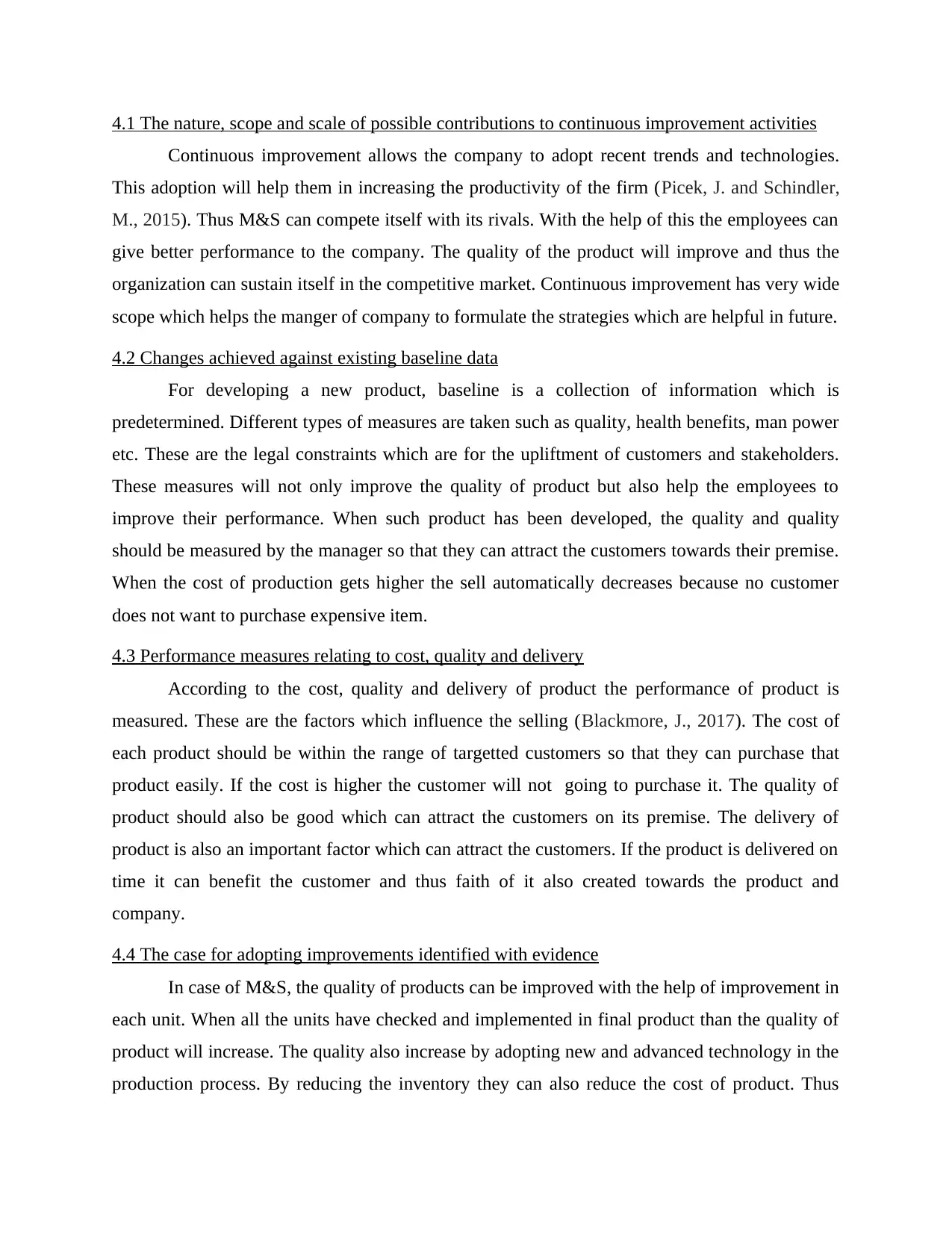
4.1 The nature, scope and scale of possible contributions to continuous improvement activities
Continuous improvement allows the company to adopt recent trends and technologies.
This adoption will help them in increasing the productivity of the firm (Picek, J. and Schindler,
M., 2015). Thus M&S can compete itself with its rivals. With the help of this the employees can
give better performance to the company. The quality of the product will improve and thus the
organization can sustain itself in the competitive market. Continuous improvement has very wide
scope which helps the manger of company to formulate the strategies which are helpful in future.
4.2 Changes achieved against existing baseline data
For developing a new product, baseline is a collection of information which is
predetermined. Different types of measures are taken such as quality, health benefits, man power
etc. These are the legal constraints which are for the upliftment of customers and stakeholders.
These measures will not only improve the quality of product but also help the employees to
improve their performance. When such product has been developed, the quality and quality
should be measured by the manager so that they can attract the customers towards their premise.
When the cost of production gets higher the sell automatically decreases because no customer
does not want to purchase expensive item.
4.3 Performance measures relating to cost, quality and delivery
According to the cost, quality and delivery of product the performance of product is
measured. These are the factors which influence the selling (Blackmore, J., 2017). The cost of
each product should be within the range of targetted customers so that they can purchase that
product easily. If the cost is higher the customer will not going to purchase it. The quality of
product should also be good which can attract the customers on its premise. The delivery of
product is also an important factor which can attract the customers. If the product is delivered on
time it can benefit the customer and thus faith of it also created towards the product and
company.
4.4 The case for adopting improvements identified with evidence
In case of M&S, the quality of products can be improved with the help of improvement in
each unit. When all the units have checked and implemented in final product than the quality of
product will increase. The quality also increase by adopting new and advanced technology in the
production process. By reducing the inventory they can also reduce the cost of product. Thus
Continuous improvement allows the company to adopt recent trends and technologies.
This adoption will help them in increasing the productivity of the firm (Picek, J. and Schindler,
M., 2015). Thus M&S can compete itself with its rivals. With the help of this the employees can
give better performance to the company. The quality of the product will improve and thus the
organization can sustain itself in the competitive market. Continuous improvement has very wide
scope which helps the manger of company to formulate the strategies which are helpful in future.
4.2 Changes achieved against existing baseline data
For developing a new product, baseline is a collection of information which is
predetermined. Different types of measures are taken such as quality, health benefits, man power
etc. These are the legal constraints which are for the upliftment of customers and stakeholders.
These measures will not only improve the quality of product but also help the employees to
improve their performance. When such product has been developed, the quality and quality
should be measured by the manager so that they can attract the customers towards their premise.
When the cost of production gets higher the sell automatically decreases because no customer
does not want to purchase expensive item.
4.3 Performance measures relating to cost, quality and delivery
According to the cost, quality and delivery of product the performance of product is
measured. These are the factors which influence the selling (Blackmore, J., 2017). The cost of
each product should be within the range of targetted customers so that they can purchase that
product easily. If the cost is higher the customer will not going to purchase it. The quality of
product should also be good which can attract the customers on its premise. The delivery of
product is also an important factor which can attract the customers. If the product is delivered on
time it can benefit the customer and thus faith of it also created towards the product and
company.
4.4 The case for adopting improvements identified with evidence
In case of M&S, the quality of products can be improved with the help of improvement in
each unit. When all the units have checked and implemented in final product than the quality of
product will increase. The quality also increase by adopting new and advanced technology in the
production process. By reducing the inventory they can also reduce the cost of product. Thus
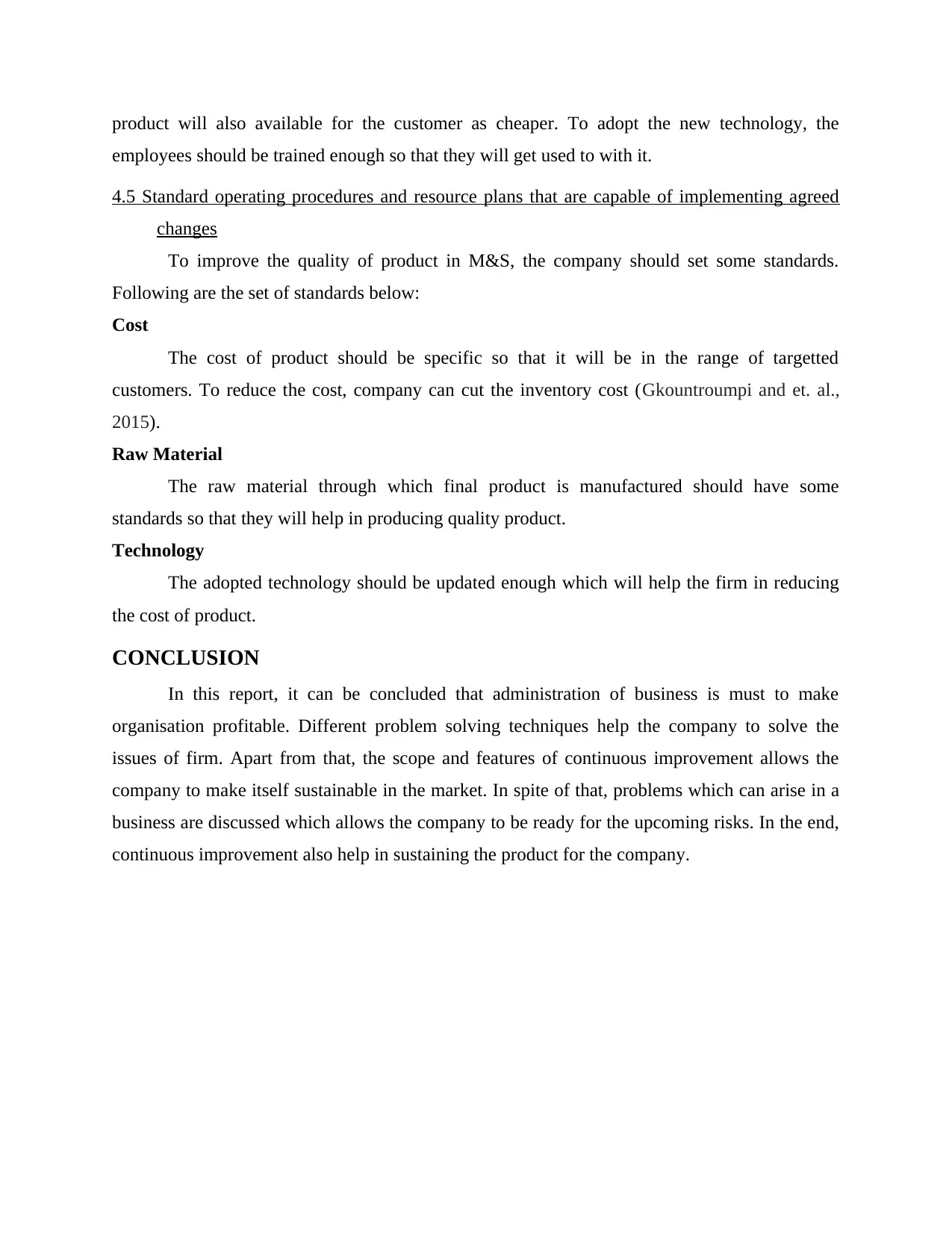
product will also available for the customer as cheaper. To adopt the new technology, the
employees should be trained enough so that they will get used to with it.
4.5 Standard operating procedures and resource plans that are capable of implementing agreed
changes
To improve the quality of product in M&S, the company should set some standards.
Following are the set of standards below:
Cost
The cost of product should be specific so that it will be in the range of targetted
customers. To reduce the cost, company can cut the inventory cost (Gkountroumpi and et. al.,
2015).
Raw Material
The raw material through which final product is manufactured should have some
standards so that they will help in producing quality product.
Technology
The adopted technology should be updated enough which will help the firm in reducing
the cost of product.
CONCLUSION
In this report, it can be concluded that administration of business is must to make
organisation profitable. Different problem solving techniques help the company to solve the
issues of firm. Apart from that, the scope and features of continuous improvement allows the
company to make itself sustainable in the market. In spite of that, problems which can arise in a
business are discussed which allows the company to be ready for the upcoming risks. In the end,
continuous improvement also help in sustaining the product for the company.
employees should be trained enough so that they will get used to with it.
4.5 Standard operating procedures and resource plans that are capable of implementing agreed
changes
To improve the quality of product in M&S, the company should set some standards.
Following are the set of standards below:
Cost
The cost of product should be specific so that it will be in the range of targetted
customers. To reduce the cost, company can cut the inventory cost (Gkountroumpi and et. al.,
2015).
Raw Material
The raw material through which final product is manufactured should have some
standards so that they will help in producing quality product.
Technology
The adopted technology should be updated enough which will help the firm in reducing
the cost of product.
CONCLUSION
In this report, it can be concluded that administration of business is must to make
organisation profitable. Different problem solving techniques help the company to solve the
issues of firm. Apart from that, the scope and features of continuous improvement allows the
company to make itself sustainable in the market. In spite of that, problems which can arise in a
business are discussed which allows the company to be ready for the upcoming risks. In the end,
continuous improvement also help in sustaining the product for the company.
⊘ This is a preview!⊘
Do you want full access?
Subscribe today to unlock all pages.

Trusted by 1+ million students worldwide
1 out of 14
Related Documents
Your All-in-One AI-Powered Toolkit for Academic Success.
+13062052269
info@desklib.com
Available 24*7 on WhatsApp / Email
![[object Object]](/_next/static/media/star-bottom.7253800d.svg)
Unlock your academic potential
Copyright © 2020–2025 A2Z Services. All Rights Reserved. Developed and managed by ZUCOL.





